Abstract
The cytopathogenic mechanisms of Trichomonas vaginalis have been debated since the 1940s. We examined the following three proposed pathogenic mechanisms: contact-dependent extracellular killing, cytophagocytosis, and extracellular cytotoxins. Serial observations of Chinese hamster ovary (CHO) cell monolayers exposed to trichomonads revealed that (i) trichomonads form clumps, (ii) the clumps adhere to cells in culture, and (iii) monolayer destruction occurs only in areas of contact with T. vaginalis. Kinetic analysis of target cell killing by trichomonads revealed that the probability of CHO cell death was related to the probability of contact with T. vaginalis, supporting the observation by microscopy that trichomonads kill cells only by direct contact. Simultaneous studies of 111indium oxine label release from CHO cells and trypan blue dye exclusion demonstrated that T. vaginalis kills target cells without phagocytosis. Filtrates of trichomonad cultures or from media in which trichomonads were killing CHO cells had no effect on CHO cell monolayers, indicating that trichomonads do not kill cells by a cell-free or secreted cytotoxin. The microfilament inhibitor cytochalasin D (10 micrograms/ml) inhibited trichomonad killing of CHO cell monolayers by 80% (P less than 0.0001). In contrast, the microtubule inhibitor vinblastine (10(-6) M) caused only 17% inhibition of trichomonad destruction of CHO cell monolayers (P less than 0.020), whereas colchicine (10(-6) M) had no effect. T. vaginalis kills target cells by direct contact without phagocytosis. This event requires intact trichomonad microfilament function; microtubule function appears not to be essential.
Full text
PDF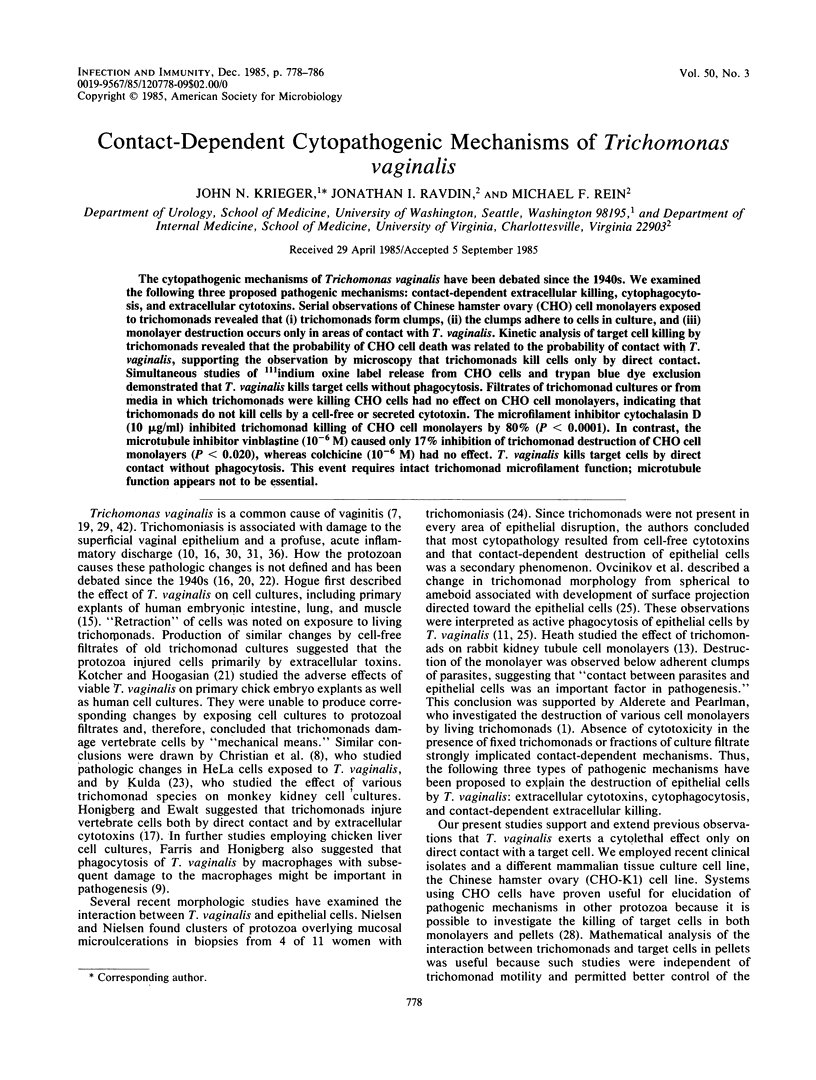
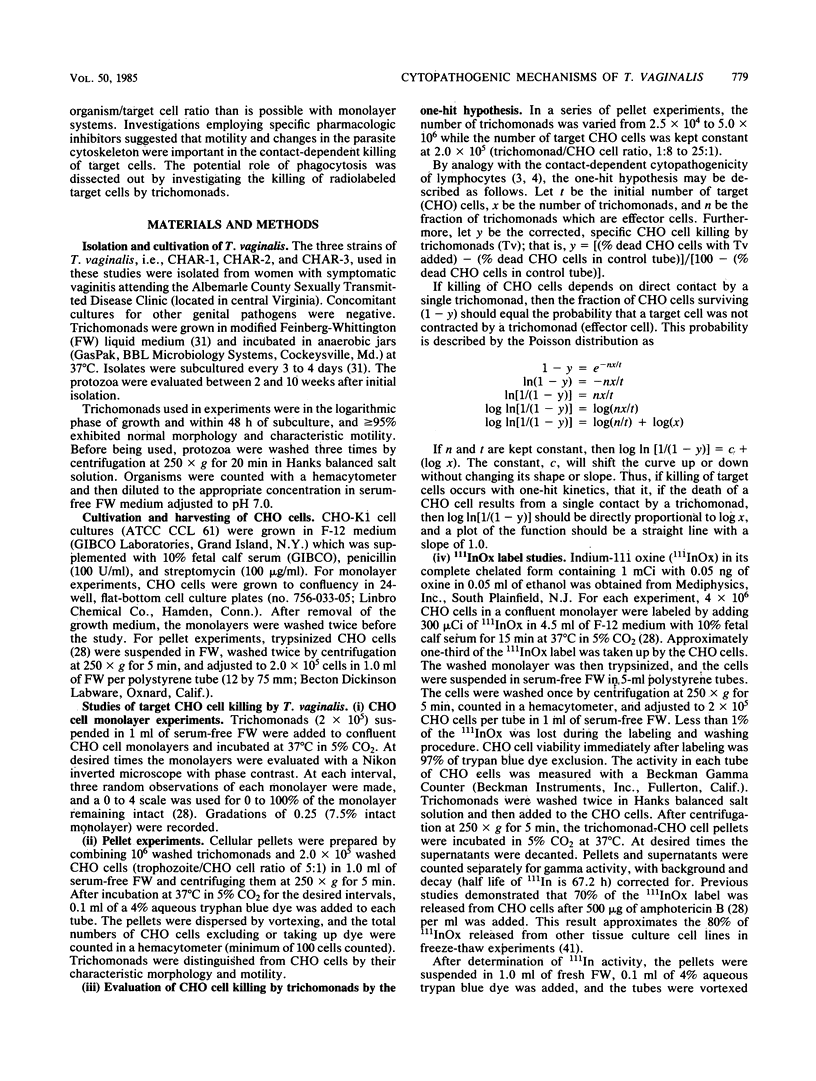
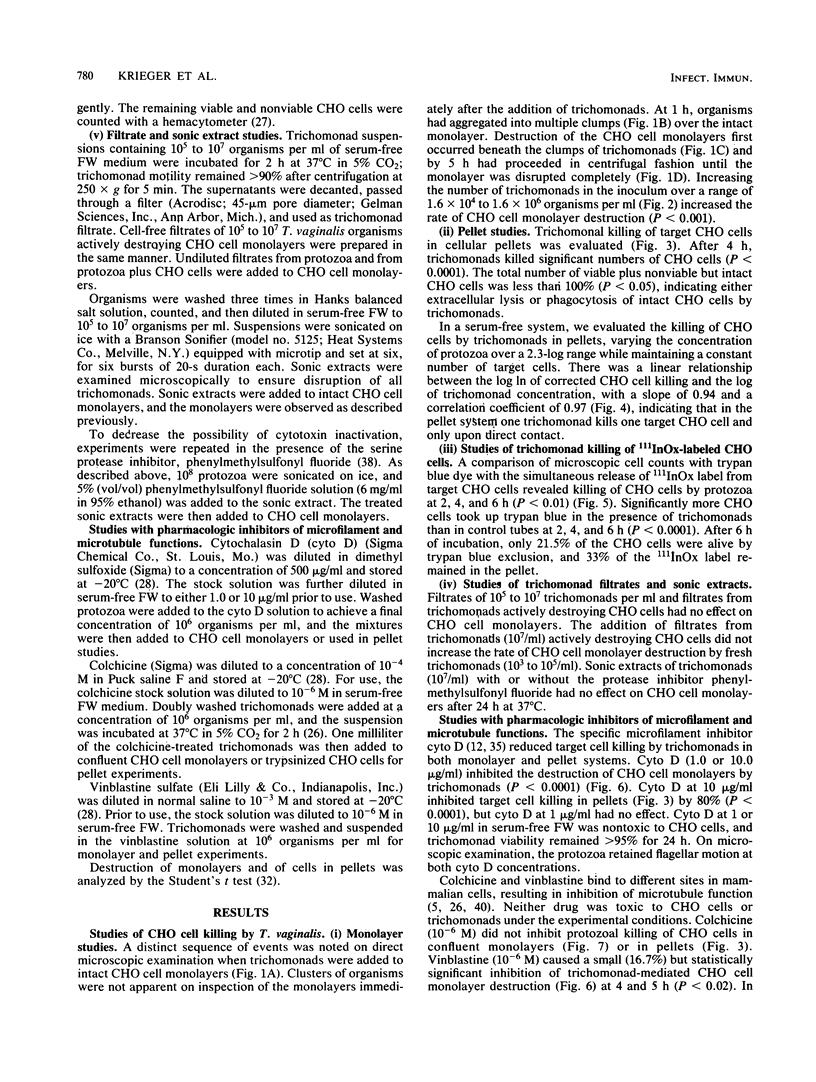
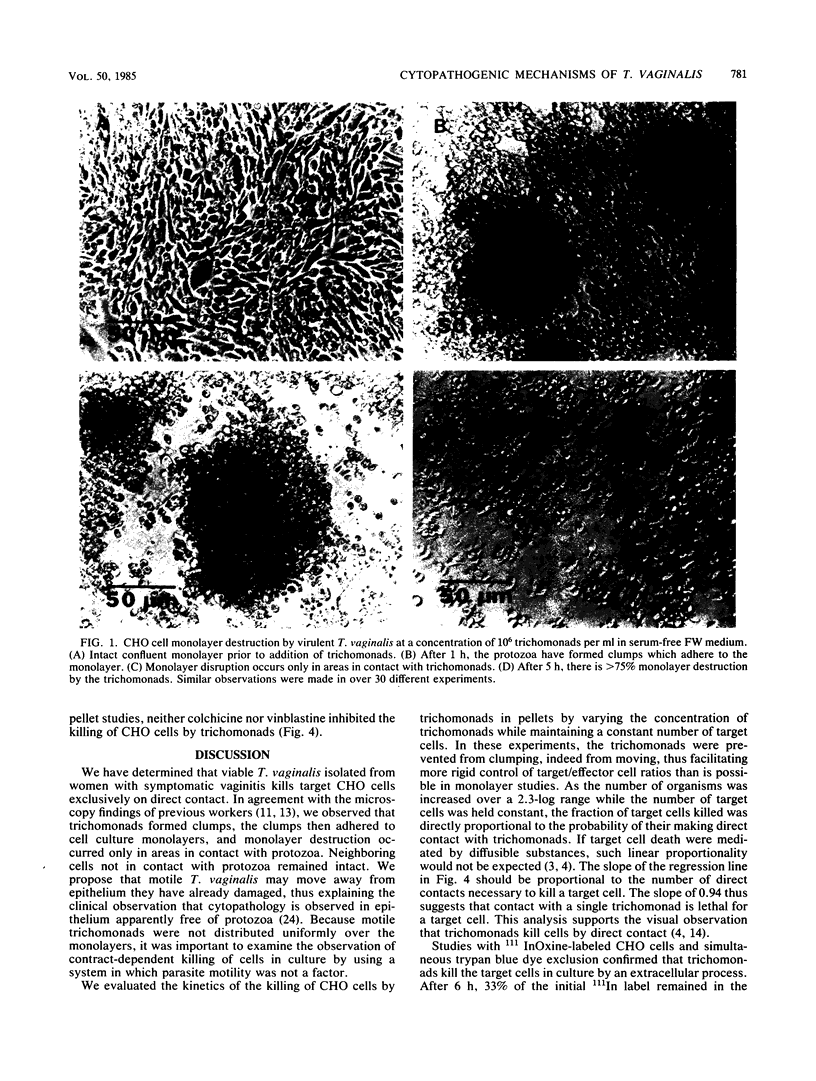

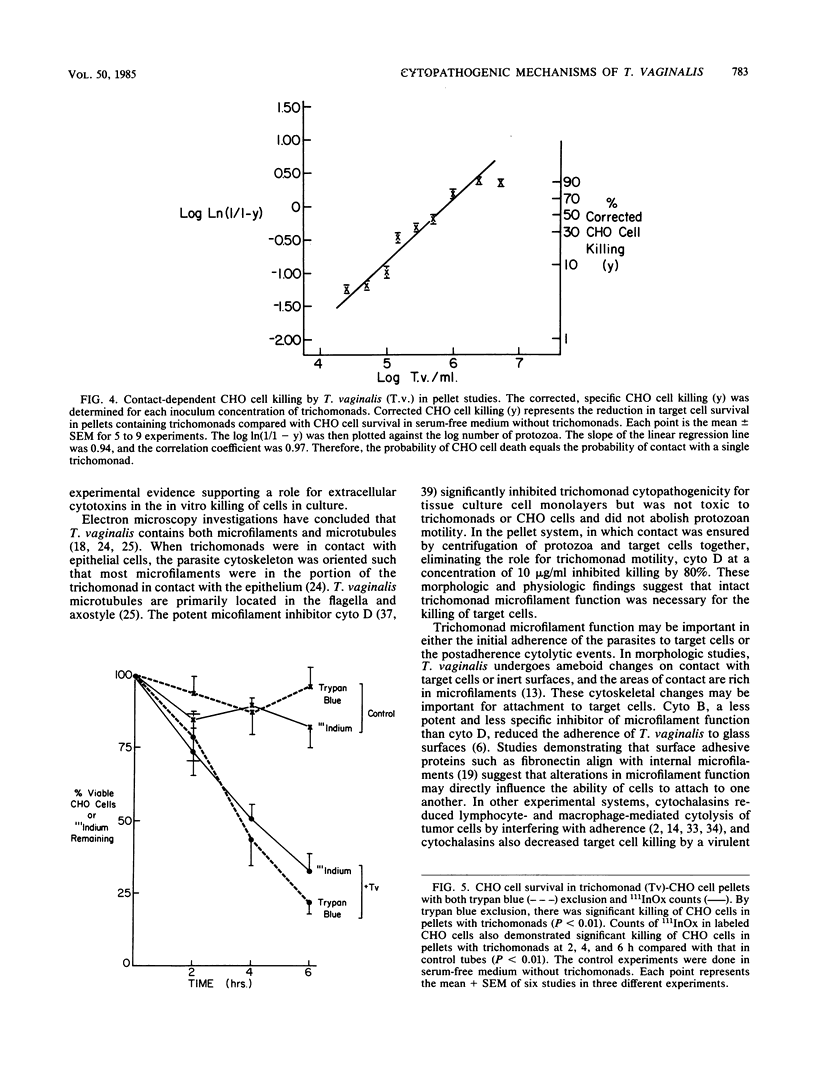
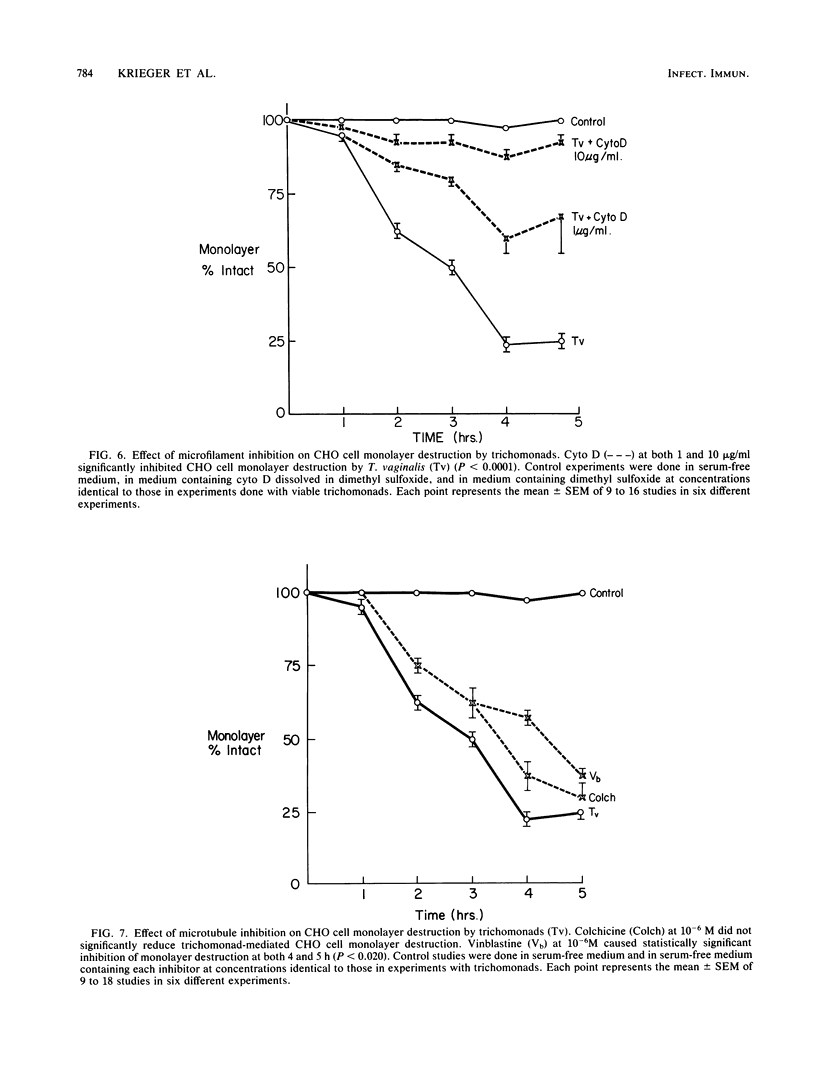
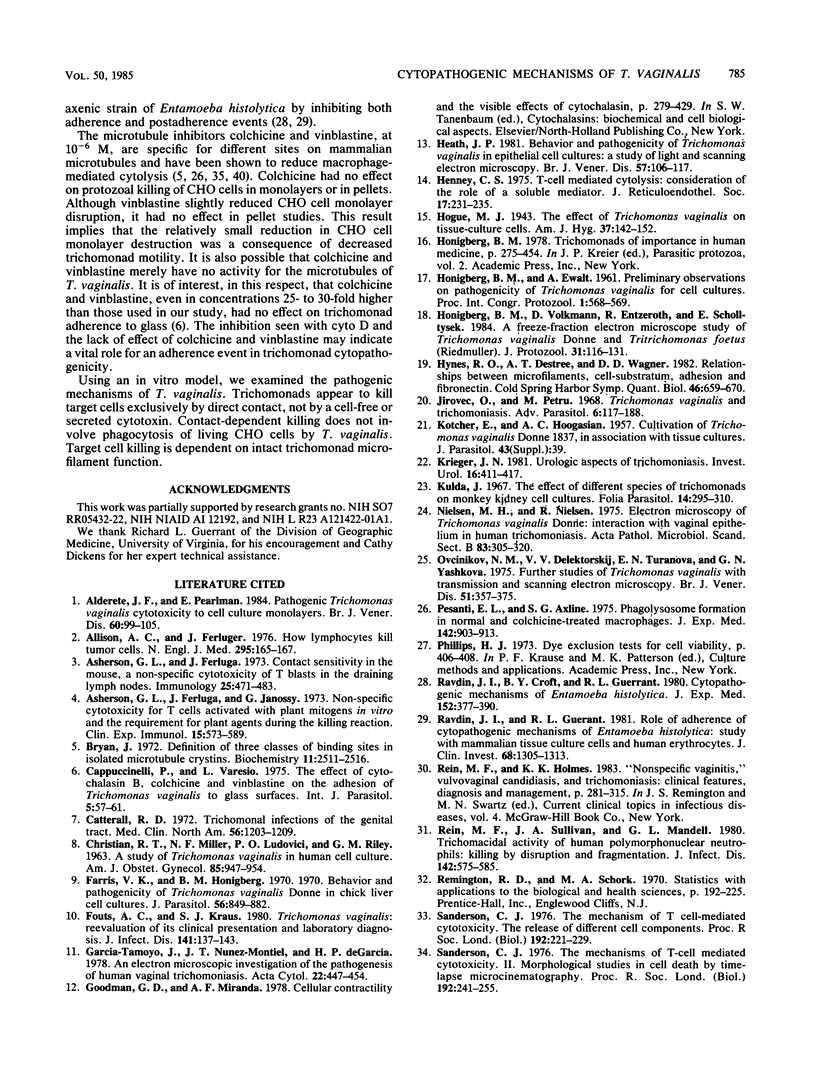
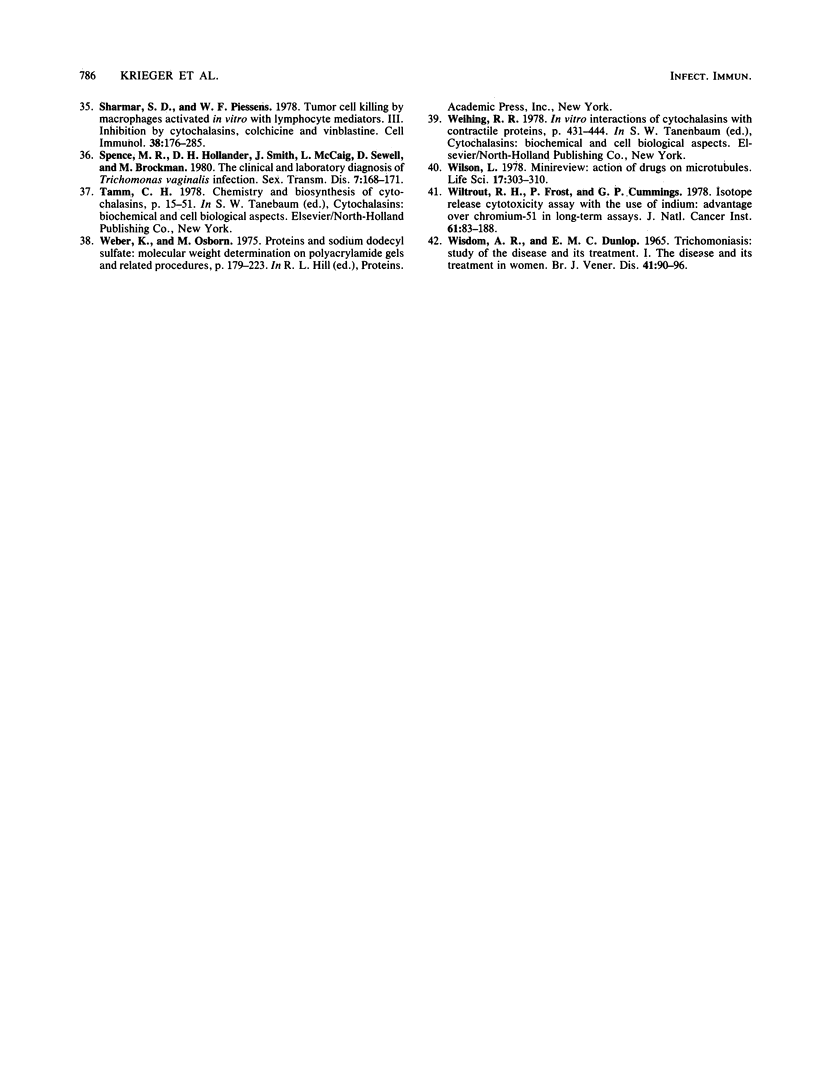
Images in this article
Selected References
These references are in PubMed. This may not be the complete list of references from this article.
- Alderete J. F., Pearlman E. Pathogenic Trichomonas vaginalis cytotoxicity to cell culture monolayers. Br J Vener Dis. 1984 Apr;60(2):99–105. doi: 10.1136/sti.60.2.99. [DOI] [PMC free article] [PubMed] [Google Scholar]
- Allison A. C., Ferluga J. Editorial: How lymphocytes kill tumor cells. N Engl J Med. 1976 Jul 15;295(3):165–167. doi: 10.1056/NEJM197607152950311. [DOI] [PubMed] [Google Scholar]
- Asherson G. L., Ferluga J. Contact sensitivity in the mouse. X. Non-specific cytotoxicity of T blasts in the draining lymph nodes. Immunology. 1973 Sep;25(3):471–483. [PMC free article] [PubMed] [Google Scholar]
- Asherson G. L., Ferluga J., Janossy G. Non-specific cytotoxicity by T cells activated with plant mitogens in vitro and the requirement for plant agents during the killing reaction. Clin Exp Immunol. 1973 Dec;15(4):573–589. [PMC free article] [PubMed] [Google Scholar]
- CHRISTIAN R. T., MILLER N. F., LUDOVICI P. P., RILEY G. M. A study of Trichomonas vaginalis in human cell culture. Am J Obstet Gynecol. 1963 Apr 1;85:947–954. doi: 10.1016/s0002-9378(16)35599-5. [DOI] [PubMed] [Google Scholar]
- Cappuccinelli P., Varesio L. The effect of cytochalasin B, colchicine and vinblastine on the adhesion of Trichomonas vaginalis to glass surfaces. Int J Parasitol. 1975 Feb;5(1):57–61. doi: 10.1016/0020-7519(75)90098-3. [DOI] [PubMed] [Google Scholar]
- Catterall R. D. Trichomonal infections of the genital tract. Med Clin North Am. 1972 Sep;56(5):1203–1209. doi: 10.1016/s0025-7125(16)32345-8. [DOI] [PubMed] [Google Scholar]
- Farris V. K., Honigberg B. M. Behavior and pathogenicity of Trichomonas vaginalis Donné in chick liver cell cultures. J Parasitol. 1970 Oct;56(5):849–882. [PubMed] [Google Scholar]
- Fouts A. C., Kraus S. J. Trichomonas vaginalis: reevaluation of its clinical presentation and laboratory diagnosis. J Infect Dis. 1980 Feb;141(2):137–143. doi: 10.1093/infdis/141.2.137. [DOI] [PubMed] [Google Scholar]
- Garcia-Tamayo J., Nuñez-Montiel J. T., de Garcia H. P. An electron microscopic investigation on the pathogenesis of human vaginal trichomoniasis. Acta Cytol. 1978 Nov-Dec;22(6):447–455. [PubMed] [Google Scholar]
- Godman G. C., Miranda A. F. Cellular contractility and the visible effects of cytochalasin. Front Biol. 1978;46:277–429. [PubMed] [Google Scholar]
- Heath J. P. Behaviour and pathogenicity of Trichomonas vaginalis in epithelial cell cultures: a study by light and scanning electron microscopy. Br J Vener Dis. 1981 Apr;57(2):106–117. doi: 10.1136/sti.57.2.106. [DOI] [PMC free article] [PubMed] [Google Scholar]
- Henney C. S. T cell mediated cytolysis: consideration of the role of a soluble mediator. J Reticuloendothel Soc. 1975 Apr;17(4):231–235. [PubMed] [Google Scholar]
- Honigberg B. M., Volkmann D., Entzeroth R., Scholtyseck E. A freeze-fracture electron microscope study of Trichomonas vaginalis Donné and Tritrichomonas foetus (Riedmüller). J Protozool. 1984 Feb;31(1):116–131. doi: 10.1111/j.1550-7408.1984.tb04300.x. [DOI] [PubMed] [Google Scholar]
- Hynes R. O., Destree A. T., Wagner D. D. Relationships between microfilaments, cell-substratum adhesion, and fibronectin. Cold Spring Harb Symp Quant Biol. 1982;46(Pt 2):659–670. doi: 10.1101/sqb.1982.046.01.062. [DOI] [PubMed] [Google Scholar]
- Jírovec O., Petrů M. Trichomonas vaginalis and trichomoniasis. Adv Parasitol. 1968;6:117–188. doi: 10.1016/s0065-308x(08)60473-x. [DOI] [PubMed] [Google Scholar]
- Krieger J. N. Urologic aspects of trichomoniasis. Invest Urol. 1981 May;18(8):411–417. [PubMed] [Google Scholar]
- Nielsen M. H., Nielsen R. Electron microscopy of Trichomonas vaginalis Donné: interaction with vaginal epithelium in human trichomoniasis. Acta Pathol Microbiol Scand B. 1975 Aug;83(4):305–320. doi: 10.1111/j.1699-0463.1975.tb00107.x. [DOI] [PubMed] [Google Scholar]
- Ovcinnikov N. M., Delektorskij V. V., Turanova E. N., Yashkova G. N. Further studies of Trichomonas Vaginalis with transmission and scanning electron microscopy. Br J Vener Dis. 1975 Dec;51(6):357–375. doi: 10.1136/sti.51.6.357. [DOI] [PMC free article] [PubMed] [Google Scholar]
- Pesanti E. L., Axline S. G. Phagolysosome formation in normal and colchicine-treated macrophages. J Exp Med. 1975 Oct 1;142(4):903–913. doi: 10.1084/jem.142.4.903. [DOI] [PMC free article] [PubMed] [Google Scholar]
- Ravdin J. I., Croft B. Y., Guerrant R. L. Cytopathogenic mechanisms of Entamoeba histolytica. J Exp Med. 1980 Aug 1;152(2):377–390. doi: 10.1084/jem.152.2.377. [DOI] [PMC free article] [PubMed] [Google Scholar]
- Ravdin J. I., Guerrant R. L. Role of adherence in cytopathogenic mechanisms of Entamoeba histolytica. Study with mammalian tissue culture cells and human erythrocytes. J Clin Invest. 1981 Nov;68(5):1305–1313. doi: 10.1172/JCI110377. [DOI] [PMC free article] [PubMed] [Google Scholar]
- Rein M. F., Sullivan J. A., Mandell G. L. Trichomonacidal activity of human polymorphonuclear neutrophils: killing by disruption and fragmentation. J Infect Dis. 1980 Oct;142(4):575–585. doi: 10.1093/infdis/142.4.575. [DOI] [PubMed] [Google Scholar]
- Sanderson C. J. The mechanism of T cell mediated cytotoxicity. I. The release of different cell components. Proc R Soc Lond B Biol Sci. 1976 Jan 20;192(1107):221–239. doi: 10.1098/rspb.1976.0010. [DOI] [PubMed] [Google Scholar]
- Sanderson C. J. The mechanism of T cell mediated cytotoxicity. II. Morphological studies of cell death by time-lapse microcinematography. Proc R Soc Lond B Biol Sci. 1976 Jan 20;192(1107):241–255. doi: 10.1098/rspb.1976.0011. [DOI] [PubMed] [Google Scholar]
- Sharma S. D., Piessens W. F. Tumor cell killing by macrophages activated in vitro with lymphocyte mediators. III. Inhibition by cytochalasins, colchicine, and vinblastine. Cell Immunol. 1978 Jul;38(2):276–285. doi: 10.1016/0008-8749(78)90058-8. [DOI] [PubMed] [Google Scholar]
- Spence M. R., Hollander D. H., Smith J., McCaig L., Sewell D., Brockman M. The clinical and laboratory diagnosis of Trichomonas vaginalis infection. Sex Transm Dis. 1980 Oct-Dec;7(4):168–171. doi: 10.1097/00007435-198010000-00004. [DOI] [PubMed] [Google Scholar]
- Tamm C. Chemistry and biosynthesis of cytochalasins. Front Biol. 1978;46:15–51. [PubMed] [Google Scholar]
- WISDOM A. R., DUNLOP E. M. TRICHOMONIASIS: STUDY OF THE DISEASE AND ITS TREATMENT. Br J Vener Dis. 1965 Jun;41:90–96. doi: 10.1136/sti.41.2.90. [DOI] [PMC free article] [PubMed] [Google Scholar]
- Weihing R. R. In vitro interactions of cytochalasins with contractile proteins. Front Biol. 1978;46:431–444. [PubMed] [Google Scholar]
- Wilson L. Action of drugs on microtubules. Life Sci. 1975 Aug 1;17(3):303–309. doi: 10.1016/0024-3205(75)90476-2. [DOI] [PubMed] [Google Scholar]
- Wiltrout R. H., Frost P., Cummings G. D. Isotope-release cytotoxicity assay with the use of indium-111: advantage over chromium-51 in long-term assays. J Natl Cancer Inst. 1978 Jul;61(1):183–188. doi: 10.1093/jnci/61.1.183. [DOI] [PubMed] [Google Scholar]



